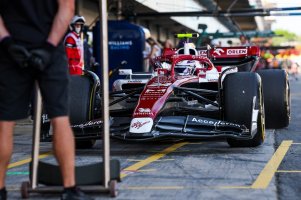F1 returns to action this week for the Spanish Grand Prix, with Red Bull and Ferrari fighting a tightly contested battle and multiple teams bringing significant upgrade packages.
A modified Circuit de Barcelona-Catalunya is the site of the 2022 Spanish Grand Prix for Formula 1. The title battle for both drivers and constructors is still a close fight, with Ferrari narrowly holding onto a lead in the constructor's championship, and Max Verstappen inching ever closer to Charles Leclerc in the drivers standings.
Much of the buzz surrounding this week's race concerns upgrades from mid-pack teams. Aston Martin arrived to Catalunya with a car that bears more than a passing resemblance to the Red Bull. Mercedes is also turning heads, as their upgraded cars look to be more on pace with Ferrari and Red Bull than we've seen so far this year.
The action this weekend will be the first time for most fans to see the track's newest form. The difficult and slow La Caixa corner at turn 10 has been rounded, which will allow the cars to carry a little more speed while still retaining the intent of the circuit overall.
Leclerc's 19-point advantage over Verstappen could be considered a safe lead in some circumstances, but given the inconsistency of the Red Bull in the first few races and coming off of two consecutive Verstappen wins at Imola and Miami, that lead seems far from safe.
Ferrari's lead in the constructor's championship has likewise been threatened, as a tough outing for Ferrari at Imola saw Leclerc and Sainz manage to finish only 6th and 20th, respectively. However, the pair claimed two of the three podium positions in Miami to help retain the championship lead.
What are your predictions for this weekend? Let us know in the comments or on Twitter @RaceDepartment!
A modified Circuit de Barcelona-Catalunya is the site of the 2022 Spanish Grand Prix for Formula 1. The title battle for both drivers and constructors is still a close fight, with Ferrari narrowly holding onto a lead in the constructor's championship, and Max Verstappen inching ever closer to Charles Leclerc in the drivers standings.
Much of the buzz surrounding this week's race concerns upgrades from mid-pack teams. Aston Martin arrived to Catalunya with a car that bears more than a passing resemblance to the Red Bull. Mercedes is also turning heads, as their upgraded cars look to be more on pace with Ferrari and Red Bull than we've seen so far this year.
The action this weekend will be the first time for most fans to see the track's newest form. The difficult and slow La Caixa corner at turn 10 has been rounded, which will allow the cars to carry a little more speed while still retaining the intent of the circuit overall.
Leclerc's 19-point advantage over Verstappen could be considered a safe lead in some circumstances, but given the inconsistency of the Red Bull in the first few races and coming off of two consecutive Verstappen wins at Imola and Miami, that lead seems far from safe.
Ferrari's lead in the constructor's championship has likewise been threatened, as a tough outing for Ferrari at Imola saw Leclerc and Sainz manage to finish only 6th and 20th, respectively. However, the pair claimed two of the three podium positions in Miami to help retain the championship lead.
What are your predictions for this weekend? Let us know in the comments or on Twitter @RaceDepartment!

